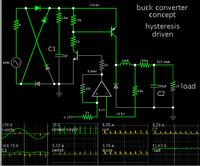David_
Advanced Member level 2
Hello.
I am trying to design my own SMPS supply and I could really need some help.
The SMPS will be used in a lab power supply with a linear post-regulator, so I am searching for a adjustable SMPS, I am reading about all different topologies but I can't make sense of which I should go with. Buck I guess but I'm not sure.
Also, I have searched for adjustable switching voltage regulators but they all need a "lower than line voltage" as input. So I still need my big line-transformer.
How would I go about designing a SMPS that uses rectified line-voltage?
I understand that such a topology would not be contained in a IC but does these topologies have a name that I can research?
Whatever I'll go for will need to be isolated.
Regards
I am trying to design my own SMPS supply and I could really need some help.
The SMPS will be used in a lab power supply with a linear post-regulator, so I am searching for a adjustable SMPS, I am reading about all different topologies but I can't make sense of which I should go with. Buck I guess but I'm not sure.
Also, I have searched for adjustable switching voltage regulators but they all need a "lower than line voltage" as input. So I still need my big line-transformer.
How would I go about designing a SMPS that uses rectified line-voltage?
I understand that such a topology would not be contained in a IC but does these topologies have a name that I can research?
Whatever I'll go for will need to be isolated.
Regards

